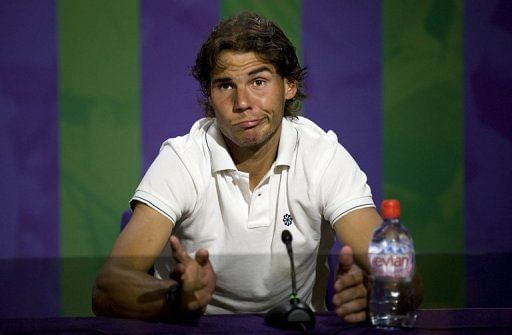
Nadal faces new year battle to rescue career
PARIS (AFP) –
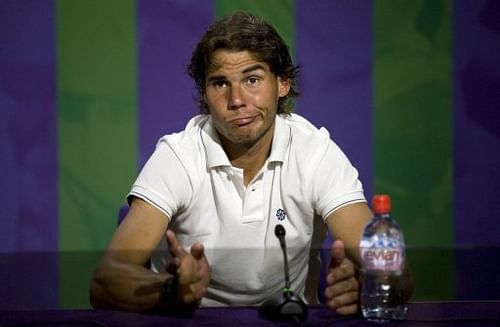
This file photo shows Rafael Nadal speaking during a press conference after his 2nd round defeat by Czech Republic’s Lukas Rosol at the Wimbledon Championships tennis tournament, southwest London, on June 28, 2012. Nadal heads into 2013 with his career in freefall and needing to summon up the no-surrender spirit that steered him to 11 Grand Slam titles.
Rafael Nadal heads into 2013 with his career in freefall and needing to summon up the no-surrender spirit that steered him to 11 Grand Slam titles, the world number one spot and $50 million in prize money.
The 26-year-old Spaniard hasn’t played since June and on Friday announced that he will skip the 2013 Australian Open because of a stomach virus.
But many in the sport believe that Nadal’s lengthy battle against knee injuries, which have plagued his career and kept him off tour since his shock Wimbledon second round loss to world number 100 Lukas Rosol, remains his prime concern.
“He told me he’s not 100 percent right now and wants to wait a little bit,” said compatriot Nicolas Almagro, who took Nadal’s place at the Abu Dhabi exhibition tournament where he had been due to make his comeback this week.
“He doesn’t want to play in Melbourne, it’s five sets, his knee’s not really good, he’s not ready for that.”
Others have hinted at a growing despondency with an injury which meant he missed the Olympics — where he was defending champion and had been due to carry his country’s flag at the opening ceremony — as well as the US Open and Davis Cup final.
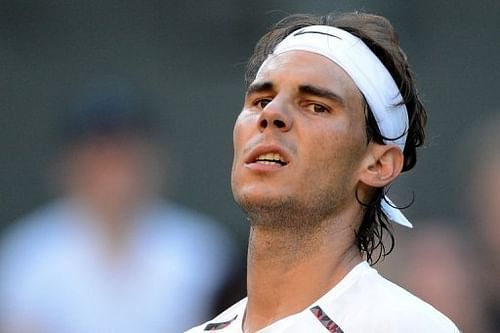
Spain’s Rafael Nadal pictured during his defeat to the Czech player Lukas Rosol at the Wimbledon Championships in Wimbledon, southwest London, on June 28, 2012. Nadal pulled out of the Australian Open on Friday, claiming he was still suffering from the stomach virus which caused him to cancel his return to action in the Gulf this week after a six-month absence.
“In August, he looked spent,” El Pais newspaper quoted a source close to Nadal’s entourage as saying. “He had been playing through pain, his head said enough.”
World number four Nadal has spent much of his career battling tendinitis in both knees, a by-product of his all-action style.
The warning signs were there in 2008 when he missed the season-ending Masters Cup and Davis Cup final.
In 2009, as four-time French Open defending champion, his 31-match winning streak on the clay courts of Roland Garros was ended in the fourth round by Robin Soderling.
He then pulled out of Queen’s and tearfully announced he wouldn’t play Wimbledon where he was defending champion as he needed to cure the tendinitis which had now developed in both knees.
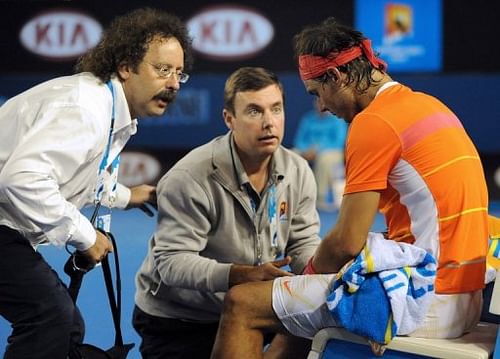
Courtside trainers attend to Rafael Nadal’s knee injury during his quarter-final match against Andy Murray at the Australian Open tennis tournament in Melbourne, on January 26, 2010. Nadal had to quit the match with a right knee injury and was out of action for two months.
In all, he was off tour for nine weeks and lost the world number one spot to Roger Federer.
It’s been a roller-coaster ever since.
At the 2010 Australian Open, he had to quit his quarter-final against Andy Murray with a right knee injury and was out of action for two months.
This year, despite winning a record seventh French Open, Nadal had already been forced to hand Murray a walkover in their scheduled Miami Masters semi-final – this time it was his left knee.
In 777 matches, it was only the second time he had been forced to give an opponent a free pass.
Nadal, who had been due to play his first official tournament in Qatar from next Monday, insists his knee is improving.
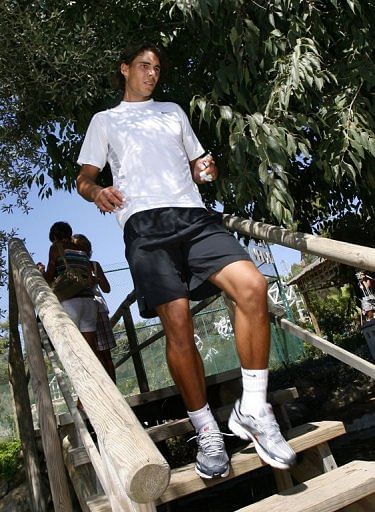
Rafael Nadal attends his first trainning session after a knee injury, in Manacor, on the Spanish Island of Mallorca, on July 20, 2009. Nadal that year lost his French Open and Wimbledon titles, as well as his world number one spot, in a summer of injury misery.
“My knee is much better and the rehabilitation process has gone well, but this virus didn’t allow me to practise this week and therefore I am sorry to announce that I will not play in Doha and the Australian Open,” he said.
“As my team and doctors say, the safest thing to do is to do things well and this virus has delayed my plans of playing these weeks.
“I will have to wait until the Acapulco tournament (in February) to compete again although I could consider playing before at any other ATP event.
“I always said that my return to competition will be when I am in the right conditions to play and after all this time away from the courts I would rather not accelerate the comeback and prefer to do things well.”
Nadal will see his ranking slip out of the top five as a result of his absence from the tour — he had 1,200 points to defend at the Australian Open after finishing runner-up to Novak Djokovic in 2012.
It will be the first time that he has fallen so low since 2005.
His decision not to play the Australian Open, where he was champion in 2009, surprised Djokovic, the current world number one.
“I got in touch with him a week ago and he was saying he was coming here, and that we’re going to practise and he said he was feeling better,” the Serb told www.sport365.com in Abu Dhabi.
“I won the Australian Open last year and I had only played this tournament in Abu Dhabi.
“Obviously for his situation right now that is quite specific, you can’t compare it to any other player because he’s been off the tour for six months so I’m sure he lacks matches and confidence.
“I wish him a fast recovery because he is someone that brings a lot to tennis with his success, his athleticism, his competitiveness. It’s not good news definitely.”